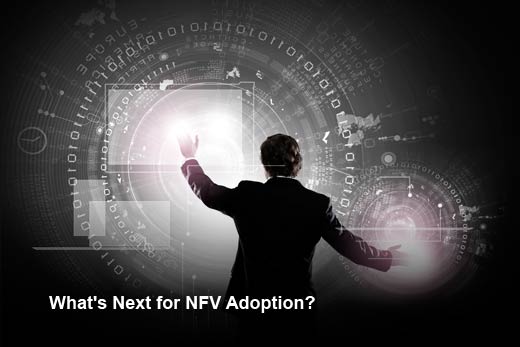For mobile operators, the evolution and adoption of Network Function Virtualization (NFV) is a positive look into the future of network operations. NFV is an initiative to virtualize network services that are currently carried out by hardware. The goal of NFV adoption is to decrease the amount of proprietary hardware needed to launch and operate network services, leading to reduced overhead costs and increased efficiency.
Full NFV adoption may take years to accomplish, but will enable network administrators to work without purchasing dedicated hardware to build a service chain. Server capacity will be able to be added through software and will eliminate the need for network administrators to overprovision their data centers, which will reduce both capital expenses (CapEx) and operating expenses (OpEx). NFV adoption will provide both increased agility and flexibility for organizations to accomplish the changing waves of network service demands.
Over the next few years, the network will see large service providers explore and start to implement a range of SDN and NFV technologies on common-off-the-shelf (COTS) platforms comprising a wide variety of use cases. In addition, NFV will become the mainstream option for service providers deploying cloud and network architectures.

The NFV Evolution
Click through for more on the NFV evolution and how it’s impacting mobile operators, as told by Xura, Inc.

What Is NFV?
Developed in 2013, Network Function Virtualization (NFV) became an evolutionary method intended to reduce costs and accelerate service deployment for network operators. By decoupling functions such as firewall or encryption from dedicated hardware, operators are able to deploy on virtual servers. This collapses multiple functions onto a single physical server, reducing costs and minimizing risks.

What It Means for Mobile Operators
For both the network and mobile operator, NFV is one of the most significant evolutionary events. The near-term benefits point to a massive reduction in capital and operational expenditures such as data center costs, which form the business case funding the investment. Longer-term benefits will be extremely impactful to the network operator as NFV will increase flexibility that will radically transform the operational business of running a telecommunications network. NFV will also provide the operator with a much greater degree of network elasticity and increased agility to adapt to market or consumer behavioral changes easily and quickly.

NFV’s Impact on Messaging Infrastructure
Through NFV adoption, the operational aspects of messaging infrastructure are significantly streamlined. This includes the ability to easily deploy virtualized software elements with centralized manageability, configure redundancy and failover, as well as dynamically scale in and out. One question many operators currently ask is which virtualization technology should they adopt within their networks. At this point, NFV is not at the level of sophistication to provide a clear answer to that question. Three virtualization strategies to consider include: software only, private cloud or public cloud based services.

Tortoise vs. Hare – Tortoise Always Wins the Race
While strong, the momentum behind NFV adoption is still slow. Along with many influential technologies, while it will take a few years until full adoption takes place, mobile operators currently see the huge market opportunity. IHS Infonetics predicts that by 2019, NFV hardware, software and services market will grow to $11.6 billion, with software taking over 80 percent of this amount. In addition, SNS Research found the NFV market will reach nearly $21 billion by 2020 and will offer CapEx savings of approximately $32 billion for wireline and wireless service providers.

What’s Next for NFV Adoption?
NFV adoption will become integrated within mobile networks and eventually lead to a fully virtualized operating system. To do so, SDN and NFV will need to coexist with traditional switches, routers and optical equipment that use custom silicon to deliver ultra-high performance. The networks of the future will see hybrid designs of specialized hardware, combined with more and more SDN and NFV elements.
Over the next few years, the industry will see large service providers explore and start to implement a range of SDN and NFV technologies on COTS platforms, comprising a wide variety of use cases. In addition, SDN/NFV will be the mainstream option for service providers deploying cloud and network architectures.














